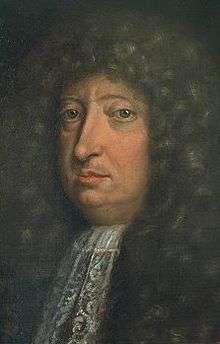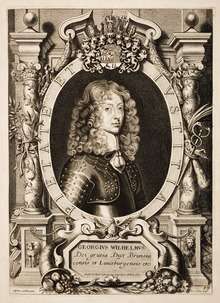George William, Duke of Saxe-Lauenburg
George William German: Georg Wilhelm (Herzberg am Harz, 26 January 1624 – 28 August 1705, Wienhausen) was the first Welf Duke of Lauenburg after its occupation in 1689. From 1648 to 1665, he was the ruler of the Principality of Calenberg as an appanage from his eldest brother, Christian Louis, Prince of Luneburg. When he inherited Luneburg on the latter's death in 1665, he gave Calenberg to his younger brother, John Frederick.
| George William | |
|---|---|
| Duke of Saxe-Lauenburg | |
 | |
| Born | 26 January 1624 Herzberg am Harz, Germany |
| Died | 28 August 1705 (aged 81) Wienhausen, Germany |
| Spouse | Eleonore d'Esmier d'Olbreuse |
| Issue | Sophia Dorothea of Celle |
| House | Hanover |
| Father | George, Duke of Brunswick-Lüneburg |
| Mother | Anne Eleonore of Hesse-Darmstadt |
Nevertheless, he only kept the sub-division of Celle, giving the rest of Luneburg to their youngest brother Ernest Augustus, whose son, George Ludwig (future King of Great Britain), inherited Saxe-Lauenburg and Celle from George William. His only daughter, Sophia Dorothea of Celle, was George Ludwig's wife.
Biography

George William was the second son of George, Prince of Calenberg. He had an elder brother, two younger brothers, and several sisters, including Queen Sophia Amalie of Denmark.
Succession
In 1648, when George William's elder brother, Christian Louis, Prince of Calenberg, inherited the Principality of Lüneburg from their paternal uncle, Frederick IV, he gave Calenberg to George William in appanage. Seventeen years later, in 1665, Christian Louis himself died childless, and George William inherited Luneburg as well. He then gave Calenberg to his next brother, John Frederick.
The renunciation of claim to Luneburg had in fact happened seven years previously, in 1658. In exchange for being freed from the obligation to marry Princess Sophia of the Palatinate, George William ceded his claim on inheriting Lüneburg to his youngest brother Ernest Augustus, settling for the smaller duchy of Celle and promising to remain unmarried so that he would produce no legitimate heir who might pose a challenge to his brother's claim to Luneburg. The absence of heirs would also mean that Celle would lapse back into Luneburg; Celle was only supposed to give George William an income for his lifetime. After reaching this agreement, George William's youngest brother, Ernest Augustus, married Sophia and became the Duke of Hanover.
Marriage and issue
This renunciation left George William free to marry whoever he wished, and indulge his desires to travel and socialize, without being encumbered by considerations of state. In 1665, George William entered into a morganatic marriage with his long-time mistress, Eleanor, Countess of Wilhelmsburg. In 1666, their only child and daughter, Sophia Dorothea, was born.
By 1676, it had become quite clear that among the four brothers (George William and three others), only the youngest, Ernest Augustus had produced any heirs male, and that the entire duchy of Luneburg was likely to be united under Ernest Augustus's eldest son George Louis. George William therefore wanted George Louis to marry his daughter Sophia, whose marriage prospects were otherwise not bright, given the circumstances of her birth. To George William's annoyance, George Louis and his parents refused the proposal on the grounds of status. At this point (in 1676),to improve the status of his mistress and daughter, and in open violation of his promise, George William legitimized his daughter and declared that his marriage to Eleonore was not morganatic but valid to both church and state. This development greatly alarmed his relatives, as it threatened to hinder the contemplated union of the Lüneburg territories. Indeed, if George William had had a son, a serious succession crisis could have arisen. No son however was born, and in 1682, George Louis' parents finally agreed to the proposed marriage as a way of avoiding uncertainty and dispute. Sophia married George Louis in 1682. They had a son and heir the following year, named George after his father and maternal grandfather: the future George II of England.
Duke of Saxe-Lauenburg
In 1689, Julius Francis, Duke of Saxe-Lauenburg died leaving no son and no accepted heir male, but only two daughters, Anna and Mary. The duchy had followed the Salic law since time immemorial, but Duke Julius Francis decided to nominate his elder daughter as his heir and proclaimed laws permitting female succession in his duchy. This self-serving innovation was not accepted by senior members of his dynasty (the other potential successors) and a succession crisis ensued.
George William was one of the nearest and senior-most male-line claimants to the succession. Shortly after the death of the duke, George William invaded the duchy with his troops and occupied it. The other claimants included the five Ascanian-ruled Principalities of Anhalt, Saxony, Saxe-Wittenberg, Sweden and Brandenburg, and also the neighbouring Mecklenburg-Schwerin and the Danish duchy of Holstein, whose ruler was the King of Denmark.
However, only George William and Christian V of Denmark (whose mother was George William's own sister) engaged militarily on this question. An accord was soon reached between them, and on 9 October 1693 they agreed (in the Hamburg Comparison, or Hamburger Vergleich) that George William - who now de facto held most of Saxe-Lauenburg - would retain the duchy in a personal union.
Meanwhile, the Emperor Leopold I, who had no direct claim on the duchy, occupied the Land of Hadeln, a Saxe-Lauenburgian exclave, and held it in imperial custody. Apart from that, Leopold did not attempt to use force in Saxe-Lauenburg. In 1728, his son the Emperor Charles VI finally legitimised the de facto takeover and enfeoffed George William's grandson and second successor, George II of Great Britain (who was also Elector of Hanover) with the duchy of Saxe-Lauenburg, but Hadeln remained in imperial custody until 1731, when it was also ceded to George II Augustus.
Other military feats
During the Swedish-Brandenburg War, George William participated from 1675 to 1676 in the campaign against Bremen-Verden as commander-in-chief of the allied forces against Sweden.
Ancestry
| Ancestors of George William, Duke of Saxe-Lauenburg | |||||||||||||||||||||||||||||||||||||||||||||||||||||||||||||||||||||||||||||||||||||||||||||||||||||||||||||||||||||||||||||||||||||||||||||||||||||||||||||||||||||||||||||||||||||||||||||||||||||||||||||||||||||||||||||||||||||||||||||||||||||||||||||||||||||||||||||||||||||||||
|---|---|---|---|---|---|---|---|---|---|---|---|---|---|---|---|---|---|---|---|---|---|---|---|---|---|---|---|---|---|---|---|---|---|---|---|---|---|---|---|---|---|---|---|---|---|---|---|---|---|---|---|---|---|---|---|---|---|---|---|---|---|---|---|---|---|---|---|---|---|---|---|---|---|---|---|---|---|---|---|---|---|---|---|---|---|---|---|---|---|---|---|---|---|---|---|---|---|---|---|---|---|---|---|---|---|---|---|---|---|---|---|---|---|---|---|---|---|---|---|---|---|---|---|---|---|---|---|---|---|---|---|---|---|---|---|---|---|---|---|---|---|---|---|---|---|---|---|---|---|---|---|---|---|---|---|---|---|---|---|---|---|---|---|---|---|---|---|---|---|---|---|---|---|---|---|---|---|---|---|---|---|---|---|---|---|---|---|---|---|---|---|---|---|---|---|---|---|---|---|---|---|---|---|---|---|---|---|---|---|---|---|---|---|---|---|---|---|---|---|---|---|---|---|---|---|---|---|---|---|---|---|---|---|---|---|---|---|---|---|---|---|---|---|---|---|---|---|---|---|---|---|---|---|---|---|---|---|---|---|---|---|---|---|---|---|---|---|---|---|---|---|---|---|---|---|---|---|---|---|---|---|
| |||||||||||||||||||||||||||||||||||||||||||||||||||||||||||||||||||||||||||||||||||||||||||||||||||||||||||||||||||||||||||||||||||||||||||||||||||||||||||||||||||||||||||||||||||||||||||||||||||||||||||||||||||||||||||||||||||||||||||||||||||||||||||||||||||||||||||||||||||||||||
References
- Allgemeine Deutsche Biographie, vol. 8, p. 634-635[permanent dead link]
George William, Duke of Saxe-Lauenburg Cadet branch of the House of Welf Born: 26 January 1624 in Göttingen Died: 28 August 1705 in Celle | ||
| German nobility | ||
|---|---|---|
| Preceded by Christian Louis |
Prince of Calenberg 1648–1665 |
Succeeded by John Frederick |
| Preceded by Christian Louis |
Prince of Luneburg 1658 |
Succeeded by Ernest Augustus |
| Preceded by Himself as Prince of Luneburg |
Prince of Celle 1658-1705 |
Succeeded by George Louis as Elector of Hanover |
| Preceded by Julius Francis House of Ascania |
Duke of Saxe-Lauenburg (illegal occupation) 1689–1705 | |
| Wikimedia Commons has media related to George William, Duke of Brunswick-Lüneburg. |